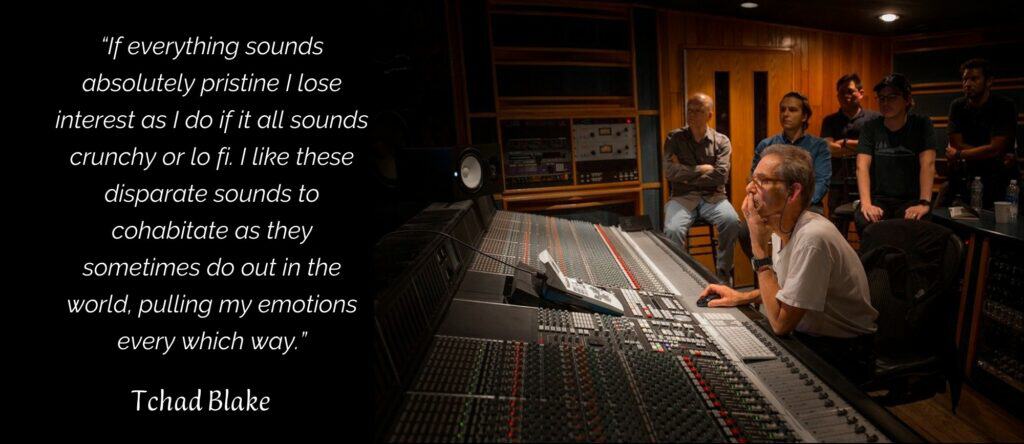New Monday #26
Happy Monday, Summer Campers!
This popped up on the Instagram feed of super-engineer Tchad Blake last week:
"There's no "best" eq for anything. All you can really say is what's your favourite at any given time. The (Korneff Audio) AlP has quickly become my favourite eq, ever. Analog or digital. Every time I use it on anything I think I'm hearing something new. It fits my ear/brain chain better than anything l've used before. Wtf...right?? How did these guys do this?? I'd love to know if anyone else out there is hearing just how cool this thing is or even, tell me how it's not. I've been using it every day for over a month and I'm still jacked up about it. "
This is a tremendous compliment, coming from this guy. Tchad Blake is king cheese, bacon from heaven. He's awesome.
Forget the credit list and awards: Tchad Blake makes really interesting recordings. He's always experimenting and inventive. He records drums in the smallest room possible using a Binaural Dummy Head as an overhead mic, doesn't use much reverb, loves to compress and distort, pans things strangely, and in general makes super cool sounds. Listen:
American Music Club "Mercury" on Apple Music
On Spotify
On YouTube
Tchad asked, "How did these guys do this??"
This is how we do it
The EQ on the AIP is a 4-band fully parametric EQ that is especially sweet sounding. It has a weird interface that is based on its inspiration, the Klangfilm RZ062B.
From the name, one can guess that Klangfilm was German and involved in sound for film. Formed in 1928 by partnership between Siemens and AEG (Telefunken), Klangfilm amplification, speakers, preamps, EQs, and home entertainment equipment was top-notch. By WW2, Klangfilm was wholly owned by Siemens, and often the names Klangfilm and Siemens are used interchangeably. Klangfilm stuff from the 50s and 60s is especially coveted.
The RZ062 was a tube EQ built for film mixing consoles. It was a three-band passive EQ with high and low shelving and either a midrange tilt EQ (the 062a) or a presence EQ (meaning upper midrange) that had 4 different frequencies (1.4kHz, 2kHz, 2.8kHz, 4kHz) with up to 5dB of gain at the selected frequency (062b).
The 062 has some similarities to the REDD 37 console used by the Beatles on Rubber Soul, Revolver, Sgt Peppers, The White Album: the REDD 37 preamps were made by Siemens.
The RZ062 is an amazing sounding EQ that is remarkably smooth and gorgeous sounding, but it's very limited in choices of frequencies, bandwidth, and overall versatility. Another common complaint is that most of the gain controls provide 2dB increments, and often a setting is either too little gain or too much.
What Dan loved about it, aside from the overall character, was the presence EQ on the 062b that worked perfectly for electric guitars.
So, Dan got his hands on the schematics and basically built the circuit digitally.
This is the usual way we make plugins—we model things at a resistor, capacitor, transformer, transistor, diode level. But what we also do is figure out what we can do with that circuit in the digital realm that would be impossible or, at the very least, difficult to do in the analog realm.
Frankenklangfilm
In the case of the RZ062, Dan decided to take a passive EQ and make it fully parametric. This makes the AIP 4-band incredibly versatile, with the sonics of the original expressed in a modern way. The AIP EQ can do anything a digital parametric EQ can do, from narrow deep cuts to ultrawide boosts, making it useful for anything from getting rid of hum and notching out vocals to finding the exact sweet spot on a snare to gentle "airband" style enhancements. The gain is adjustable out to a ridiculous 36dB of boost and cut, and we've even modeled some EQ curve goofiness that can happen with vintage passive equalizers.
Is it an exact recreation of a RZ062b? No, but at certain settings it can precisely replicate the response curves of the original. We consider it more the Klangfilm's mutant cousin. Frankenklangfilm.
One thing that hasn't changed from the original, however, are the tube/transformer input and output stages, which are a big reason the AIP EQ is so sweet sounding. The original circuit design tends to saturate the transformers a bit. The result is that the input signal is harmonically enhanced feeding into the equalizing circuitry, and then the EQ'd signal is rounded off a bit by the output.
So, that's the quick version of what's going on with the EQ on the AIP. If you want to grab an AIP Demo, click here.
Amazing Interview
Gearspace did an interview with Tchad a few years ago. It's detailed, funny, and he gives away the store and the secrets.
I have been sick with a summer cold and tinnitus all week, and I'm behind on answering a bunch of you that wrote in. I'll get back to you all this week. It's always a delight writing New Monday and hearing from you guys.
Next week I think we need to do a survey about how I can make New Monday better and more useful for you.
Warm regards,
Luke@KorneffAudio.com


